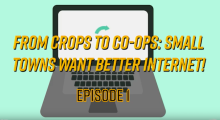Animated Video Series Explores Rural Connectivity: "From Crops to Co-ops"
In rural communities, large companies often won’t invest in high-quality Internet network infrastructure due to the lack of population density. Increasingly, rural electric and communications cooperatives are filling the void and providing the Internet access small towns and surrounding areas need. In order to illustrate the challenges facing these small rural towns, we’ve developed a series of videos titled, “From Crops to Co-ops: Small Towns Want Better Internet!”
The series includes five episodes that tell the story of one small town, its residents, and the way they tackle the need for better local connectivity. In addition to our story about the folks from the imaginary community of "Villageville," we include real-life statistics about connectivity in rural communities.
In the first episode, we’ve introduced some of the characters that will take us through the series as we catch up with them outside the local library. You'll learn why they're hanging out in the parking lot and get a better understanding of what life is like in a rural community where small towns want better Internet access.
Share this resource with others who are interested in exploring options for improving connectivity in their local communities.
We’ll share more episodes that document Villageville's journey in the coming weeks.
UPDATE:
We've published all five episodes! Watch them here to find out what happened in Villageville:
Episode 2:
Episode 3:
Episode 4:
Episode 5:




